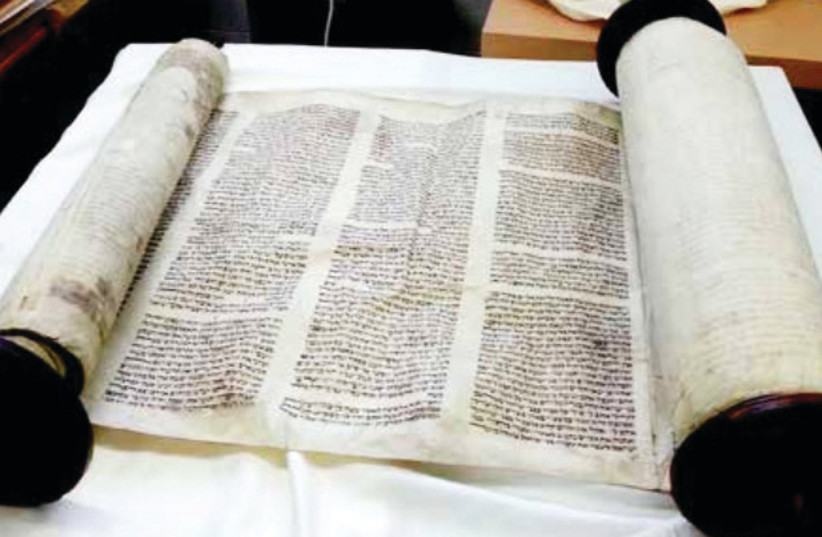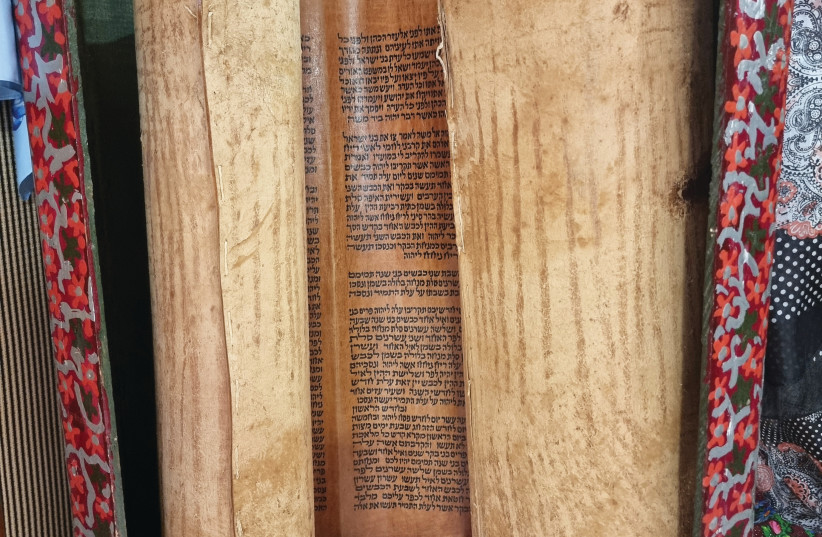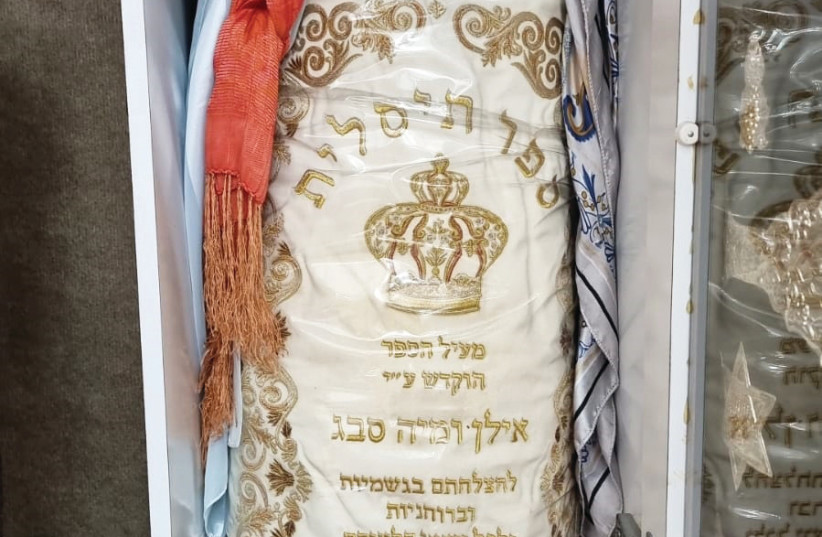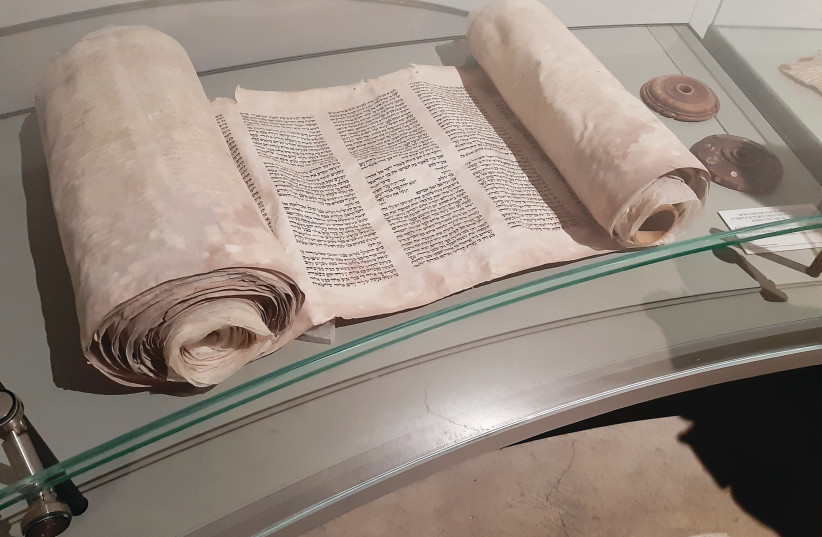A photo essay captures the stories of six Torah scrolls from around the world – Yemen, Siberia, France, Germany – which all ended up in Israel.
ILANA SHTOTLAND
OCTOBER 14, 2021 17:41

Yemenite Torah scroll

This 300-year-old Torah scroll is located at the Yemenite Jewish Heritage Center in Rehovot.
“This Torah scroll was donated to the museum by the Moshe family, which made aliyah to Israel from Sa’adah, Yemen,” explains Hananya Koresh, the director of Yemenite Jewish Heritage Center in Rehovot.
“The Torah scroll itself is over 300 years old and is made of gevil parchment, as are all Yemenite Torah scrolls. The scroll is still housed in its original wooden case, which has eight ribs. Wooden Torah cases are usually either painted or covered with embroidered cloth. Yemenite Torah scrolls are different from Sephardic and Ashkenazic scrolls in a number of ways. Firstly, the former has 51 lines on each page of parchment, while the latter contains only 42 lines. In addition, pages in Yemenite Torah scrolls always begin with the first word of a verse.”
What’s unique about this specific Torah scroll?
“First of all, it’s extremely old. Also, it has been preserved in its entirety, since the region it hails from in Yemen is very dry, and there’s never any humidity there. It still has its original parchment, case and bells. It’s extremely rare to find a Torah scroll that’s hundreds of years old in such good condition. The Moshe family read from this Torah back in Yemen, and along with this, they also brought a number of special hand-written manuscripts that are also on display at the museum.”
Tislit Torah scroll

This centuries-old Torah scroll is located in the Sefer Tislit Synagogue in Ashkelon.
“The Tislit Torah scroll is ancient – it was written hundreds of years ago, and was brought to Israel from the village Tazenakht in Morocco,” explains Rami Ivgi, the administrator of the Sefer Tislit Synagogue in Ashkelon. “It was carried to Israel in 1963 by my father’s family, Rabbi Nisim and Yaakov Wiseman. The scroll was written together with another six scrolls in Jerusalem, and then they were taken to communities outside of Israel. This one found its way back to Israel.
“This Torah scroll has many virtues and many believe it has the power to carry out miracles and wonders. It’s considered very holy. The sofer that wrote the Torah scroll was a holy man, but we don’t know what his name was. People come from all over Israel and the world to set their eyes upon this special Torah scroll. People come in search of this scroll when they are in need of help finding a spouse, getting pregnant, or attaining protection. Every year at the beginning of the month of Heshvan, we hold a great celebration in honor of this Torah scroll. This year, because of COVID, we’ll be holding a gathering with a small group of participants.”
Siberian Torah scroll
This 100-year-old Torah scroll is located at the Chasidei Radomsko Synagogue in Bat Yam.
“My late grandfather, Rabbi Menachem Mendel Hager, who was a member of Israel’s Provisional State Council and the founder of the Tel Aviv Hevre Kadisha, was born in Poland and was the rabbi of the city Sosnowiec,” says David Eliezer Aharon Hager, administrator of the Chasidei Radomsko Synagogue in Bat Yam.
“After World War II broke out, my family took the Torah with them when they were exiled to the forests of Siberia with many other Polish Jews. Three years later, my grandfather headed a delegation that went to present their case to a famous high-ranking Russian general, who in the end agreed to release my family and hundreds of other Polish Jews and allow them to leave for Israel. Then, right at the end of the meeting, the general took my father aside and handed him something large that was covered with a dirty jute cloth. It was a Torah scroll that the general’s father, who was Jewish, had made his son promise to hand off to someone who could bring it to the Land of Israel.”
Where did this Torah scroll end up?
“My grandfather made aliyah in 1942, and for many years the Torah was passed around from one synagogue to another in Bat Yam. Anytime they would hear about a congregation that didn’t have a Torah, or was repairing one, they would lend it out to them. Until this day, this Torah is constantly lent out to those who need it. During COVID-19, it was brought to Ginot Shomron, where my nephew Menachem Hager is the administrator, so that his son could read from it at his bar mitzvah.”
Leipzig Torah scroll

The Torah scroll from the Jewish community in Leipzig, Germany is located at Yad Vashem.
“The Torah scroll from the Brody Synagogue in Leipzig, Germany was saved 60 years ago during Kristallnacht in 1938 when many synagogues all over Germany and Austria were burned down,” explains Michael Tal, director of the Artifacts Department at Yad Vashem.
“Most of the Torah scrolls that were in synagogues the night of Kristallnacht were destroyed. Very few were saved. The most unique aspect of this Torah scroll, which is currently on display at Yad Vashem, is that the details of where and by whom it was hidden, and which synagogues read from it are known. Thus, this Torah scroll serves as a detailed testimony of the people who survived the pogroms.”
A few months ago, the Leipzig Torah scroll was removed from the exhibition since the ink had faded and mold stains were found on it. It is currently being restored by Haim Shushan, the paper conservator at Yad Vashem in the museum’s restoration department. Afterward, it will be returned to the exhibition.
Wiesloch Torah scroll
The Torah scroll from the Jewish community in Wiesloch, Germany is located at Shem Olam Institute.
One of the most well-known tragedies from the pre-state period in Israel was the accidental sinking of the Patria, an ocean liner that was carrying hundreds of Jewish refugees from Europe whom the British had refused to let enter Mandatory Palestine. In November 1940, the British authorities had combined Jewish refugees from three separate ships trying to reach the shores of the Land of Israel, and placed them all on the Patria, which was to sail for Mauritius, where they refugees were to be placed in DP camps.
In an effort to stall the sailing of the ship, the Hagana had planted a bomb on the ship while it had been moored at Haifa Port. The plan had been to slightly impair the ship just enough to make it unsafe for sailing. Unfortunately, the mission did not go as planned, and the Hagana agents had miscalculated the strength of the explosives. The ship sank in a matter of minutes, trapping hundreds of the passengers in the ship’s hold. The Patria disaster took place on November 25, 1940, taking the lives of at least 208 Jewish refugees.
“Among the Jewish refugees on the Patria were Bernard and Yohana-Hana Hamburger, who had decided to make aliyah to Palestine, where they would join their daughter Ruth who’d made the trip a year earlier,” describes Rabbi Avraham Krieger, director of the Shem Olam Institute.
“The Hamburgers were from Wiesloch in Germany, and they were bringing with them the Torah scroll from their synagogue, since there were no Jews left in Wiesloch.”
According to Ruth Hamburger, her father Bernhard had managed to disembark from the ship before the explosion took place, but he returned to the ship in an effort to help his wife and carry the Torah scroll. Just as he reached the ship, however, the explosion took place, and the scroll fell into the water. He jumped in to try to save the scroll, but unfortunately, he drowned. His wife Yohana-Hana swam to shore, where she was caught by the British, who sent her to live in the DP camp in Atlit. Apparently, someone else grabbed the Torah scroll and it was returned to the Hamburger family. The Torah scroll was given to the Heichal Shalom Synagogue in Tel Shalom. In 2014, the Torah was donated to Shem Olam to serve as a testimony of the harrowing events the family went through to try to save the Torah scroll. It represents the spirit of a community that was wiped out.”
Cairo Torah scroll

This decades-old Torah scroll from the Jewish community in Cairo, which was written in memory of the Olei Hagardom, is located at the Achdut Yisrael Synagogue in Jerusalem.
“Two years ago, when I was at the Achdut Yisrael Synagogue in Jerusalem, the administrator told me the story about this Torah scroll and asked if we could repair it so that it could be read from on the Sabbath and holidays. It is a very unique Torah scroll, and we had it refurbished,” explained Yitzhak Goldstein from Machon Ot, which repairs Torah scrolls.
“Apparently, Lehi members Eliyahu Hakim and Eliyahu Beit-Zuri were sent by their Lehi commanders to assassinate Lord Moyne in Cairo,” continued Goldstein. “They carried out their mission on November 6, 1944, but were caught on March 22, 1945 and were summarily executed by hanging. The Jewish community in Cairo dedicated a Torah scroll to them, which they used in their synagogue until it was brought to the Beit Ora Synagogue in Montreal, Canada in 1962. Later, the scroll was brought to Israel and is currently located in Achdut Yisrael Synagogue in Jerusalem.
Alsace Torah scroll
This 100-year-old Torah scroll from Alsace, France is located at the Gush Katif Museum in Jerusalem.
“I used to export Israeli agricultural products to Europe, and a few times when I would return home to Israel, I would bring Torah scrolls back with me from places where there are no longer Jewish communities,” says Shlomo Wassertile, from Moshav Ganei Tal. “Most of the Torah scrolls had not been read from in decades, since the Holocaust. Once they are brought to Israel, they are ‘brought back to life.’
“In 1998, on one of my trips to France, I was visiting with friends, who took me to see dozens of Torah scrolls in Wintzenheim, which is located in Alsace, in northeastern France. They asked me to take one, so I had to pick the one that looked like it was most likely to be kosher and not pasul (unfit for reading). I remember the night we went to the old synagogue – it was minus 15 degrees out – and searched for the Torah that looked like it was the most intact. It was over 100 years old.”
Where did this Torah scroll end up?
“Well, at the time I was living in Gush Katif. Everyone knew that I would bring Torah scrolls to Israel, and one day I got a call from the principal of the school in Neveh Dekalim asking if they could have it. Then, in 2005, when Israel withdrew from the Gaza Strip, we were all ejected from our homes. I stayed there until the very last moment I could. I went into the synagogue of the school and opened up the holy ark and took out the Torah scroll. When the Gush Katif Museum opened in Jerusalem, I donated the Torah scroll to it. I included a written description of the Torah’s history for all the visitors to read.”
Translated by Hannah Hochner.
Content retrieved from: https://www.jpost.com/judaism/bible-scrolls-from-around-the-world-in-pictures-682018.